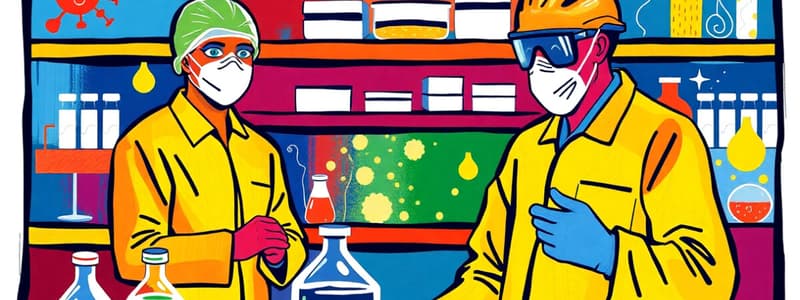Podcast
Questions and Answers
What should you do if you need to touch a common surface while carrying lab materials?
What should you do if you need to touch a common surface while carrying lab materials?
- Remove your gloves before touching any surface.
- Use your ungloved hand to touch the surface. (correct)
- Carry the lab materials without touching any surfaces.
- Use your gloved hand to touch the surface.
Which of the following actions is NOT safe to perform in a laboratory?
Which of the following actions is NOT safe to perform in a laboratory?
- Using laboratory equipment under supervision. (correct)
- Adjusting contact lenses.
- Pipetting substances by mouth.
- Consuming food or drinks.
What is recommended regarding the cleanliness of the lab bench during an experiment?
What is recommended regarding the cleanliness of the lab bench during an experiment?
- You should keep the bench cluttered with your belongings.
- Only lab materials and the lab manual should be present. (correct)
- Personal items should be kept on the bench for easy access.
- It is acceptable to leave the bench messy if the experiment is interesting.
What should you do before and after each lab experiment?
What should you do before and after each lab experiment?
When working in a laboratory, which behavior should be avoided?
When working in a laboratory, which behavior should be avoided?
What is primarily emphasized for the protection of laboratory personnel?
What is primarily emphasized for the protection of laboratory personnel?
Which biosafety level is most commonly used in undergraduate laboratories?
Which biosafety level is most commonly used in undergraduate laboratories?
What is an important safety practice regarding lab coats?
What is an important safety practice regarding lab coats?
Which of the following is a key potential hazard in the laboratory?
Which of the following is a key potential hazard in the laboratory?
What is the recommended action if a lab coat catches fire?
What is the recommended action if a lab coat catches fire?
What should you do with long hair and loose clothing when working with open flames?
What should you do with long hair and loose clothing when working with open flames?
What is required when working with UV light or procedures involving splashing chemicals?
What is required when working with UV light or procedures involving splashing chemicals?
Which type of shoes should be worn during laboratory work?
Which type of shoes should be worn during laboratory work?
What emergency equipment should always be located in the laboratory?
What emergency equipment should always be located in the laboratory?
What is the primary purpose of chemical hygiene plans in laboratories?
What is the primary purpose of chemical hygiene plans in laboratories?
What should you do first in the event of a lab emergency?
What should you do first in the event of a lab emergency?
Where should biohazardous waste be disposed of?
Where should biohazardous waste be disposed of?
What should be done with sharp objects in the lab, like scalpels, to prevent injuries?
What should be done with sharp objects in the lab, like scalpels, to prevent injuries?
Which statement about safety glasses is true?
Which statement about safety glasses is true?
In a laboratory setting, what is the role of fume hoods?
In a laboratory setting, what is the role of fume hoods?
Flashcards are hidden until you start studying
Study Notes
Laboratory Safety
- Laboratory safety involves procedures to protect personnel and ensure safe use of equipment.
- It includes protocols for disposal of contaminated materials and chemicals.
Potential Laboratory Hazards
- Hazards can include corrosive chemicals, sharp objects, open flames, and infectious organisms.
- Microorganisms are classified into four biosafety levels based on their ease of transmission and pathogenicity.
- BSL 1 organisms are generally not harmful to immunocompetent individuals, while BSL 4 organisms require specialized laboratories and extensive safety measures.
Standard Practices in the Laboratory
- Lab Coats: Wear lab coats to protect from contamination and potential splashes. Ensure they are long enough for proper coverage and not restrictive.
- Gloves: Wear gloves to protect hands from contamination, chemicals, and staining agents. Never touch common surfaces with gloved hands.
- Eating and Drinking: Never consume food, drink, or chew gum in the laboratory. Avoid mouth pipetting.
- Applying Makeup and Adjusting Contacts: Avoid applying makeup or adjusting contacts within the lab.
- Clean Benchtop: Keep the workspace clean and only include necessary materials. Store personal items away from the benchtop.
- Unattended Experiments: Do not leave active experiments, heated materials, or visible reactions unattended.
- Disinfecting Surfaces: Disinfect the benchtop before and after each lab exercise.
- Hand Hygiene: Keep hands clean, wash them thoroughly before and after each lab exercise, and after contact with potential hazards.
- Laboratory Etiquette: Never run in the laboratory, sit on laboratory benches, or perform unauthorized experiments.
Personal Safety
- Hair and Clothing: Tie back long hair and secure loose clothing, especially around open flames.
- Eye Protection: Wear goggles, safety glasses, or face shields when working with UV light, aerosols, or chemicals that may splash into the eyes.
- Footwear: Wear closed-toed shoes to protect feet from chemical spills and sharp objects.
Laboratory Safety Equipment
- Eyewash and Chemical Shower: Know the location of these equipment for emergencies.
- First Aid Kit and Fire Extinguisher: Locate these safety equipment in the laboratory.
- Fume Hoods and Biosafety Cabinets: Utilize these as directed for chemical and biological safety.
Waste Disposal
- Biohazard Bin: Dispose of contaminated items, such as gloves, in properly labeled bins or bags.
- Sharps Containers: Use for the disposal of broken glass, needles, scalpel blades, and other sharp objects.
- Trash Cans: Non-contaminated waste paper and other trash should be disposed of in regular trash cans.
- Reusable Materials: Sterilize reusable materials in an autoclave or wash them in the sink after use.
Chemical Handling
- Closed Containers: Keep chemical containers closed to prevent dust and vapor escape.
- Unmarked Reagents: Never use unmarked or unidentified reagents.
- Safe Handling: Handle chemical bottles safely, using suitable carrying arrangements and avoiding direct contact with the neck or body.
- Dilution of Acids: Always add acid to water, stirring continuously, for proper dilution.
- Chemical Disposal: Dispose of chemicals according to specific instructions.
Hand Washing Technique
- CDC Hand Washing Steps: Follow the CDC's recommended hand washing technique for thorough cleaning:
- Remove jewelry.
- Wet hands with running water and apply soap.
- Rub hands together to create a lather.
- Scrub for at least 20 seconds, including back of hands, between fingers, and under nails.
- Rinse hands thoroughly with running water.
- Dry hands with a clean towel or air dry.
Units of Measurements
- SI System: The SI system is the standard measurement system used by scientists.
- Prefixes: The SI system uses prefixes like "kilo," "milli," "micro," and "nano" based on multiples of 10.
- Importance of Units: All measurements require both a number and a unit.
Studying That Suits You
Use AI to generate personalized quizzes and flashcards to suit your learning preferences.




